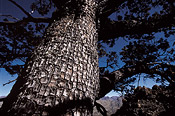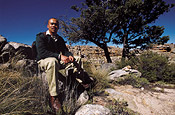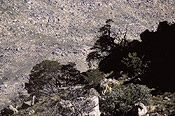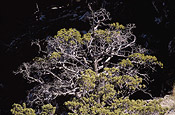For more pictures, see the photo gallery here.
Introduction
The Clanwilliam cedar is a majestic tree of 6-18 m in height, endemic to the Cederberg Mountains in the Western Cape Province of South Africa.
Why is this species important?
The Clanwilliam cedar is one of the few trees found in the shrub-dominated fynbos vegetation of the Cape region of South Africa. Historically it played a critical role in the development of the area, being an important source of timber for the early European settlers in this largely treeless region. From the beginning of the eighteenth century, its fragrant, rot-resistant and aesthetically beautiful timber was extensively exploited for building, furniture and later for telegraph poles. Although harvesting of live trees has been banned for the past 100 years, the Clanwilliam cedar is still a characteristic and much-valued component of the Cederberg Mountain vegetation.
Where is it found?
The Clanwilliam cedar is only found in the Cederberg Mountain range in the Western Cape Province of South Africa. The mountains lie between latitudes 32° 00’S and 34°45’S and longitudes 18°50’E and 19°25’E. The cedars grow on cliffs, rocky outcrops and slopes, largely between 1050 m and 1650 m above sea level. In the northern part of its range, the tree appears to occur mainly on the eastern slopes, but no such limitation exists in the rest of its range. In the early nineteenth century travellers to the area wrote of a forest “24 miles long and two miles wide”. Today the cedar occurs as individual trees with many dead relicts over a much-reduced area: it is estimated that an area of 60-70,000 ha of dense woodland has been reduced to 25,000 ha of scattered trees. If they do not succumb to fire, the cedars can live for up to 400 years.
How do people use it?
The Clanwilliam cedar was extensively exploited for timber in the eighteenth and nineteenth centuries, initiated by the arrival of the early European settlers in the region. It produces a fragrant, durable timber with an attractive appearance, which was used for construction, furniture and telegraph poles. Harvesting of live trees has been banned for the past 100 years.
Why is it threatened?
A combination of factors seems to have led to the decline in the species. The extensive exploitation by man clearly played an important role in diminishing numbers in the eighteenth and nineteenth centuries, although evidence suggests that the ecological situation of the cedar was fragile even before that time due to climatic changes. Although harvesting of the trees has been banned for 100 years, the number of cedars has continued to decline and there is little sign of re-establishment of young trees. An increase in the frequency of large-scale, intense fires is believed to be responsible, although fire is also essential for the natural regeneration of the species. It takes up to 30 years for a tree to bear seeds, and it seems that the increased frequency of fires means that few saplings live to reproduce before fire kills them. It also appears that the seed bank in the natural stands of mature trees has fallen below a self-sustaining level. A large fire in 1989 destroyed hundreds of trees and is believed to have been particularly significant in the recent failure in cedar regeneration. Consumption of the seeds and young shoots by rodents has also been cited as a contributory factor.
What conservation action is needed?
Without large-scale planting of seedlings, the Clanwilliam cedar is unlikely to recover. An IUCN action plan for the species concludes “the only option open to increase cedar numbers is now found to lie in a large-scale planting scheme of nursery-grown seedlings in newly burnt areas and careful management of the burning regimes.” Fires need to be prevented or controlled until seedlings have reached reproductive maturity (15-30 years). Western Cape Nature Conservation (WCNC) established a cedar nursery and planting programme in the late 1980s, but due to lack of funds, it had to be abandoned in the late 1990s. As part of the Global Trees Campaign, FFI is now assisting the Botanical Society of South Africa, working with the WCNC, to re-establish the nursery and planting programme - for more information please see the project page here.
Selected references
Farjon, A. and Page. C. (1999). Conifers: status survey and action plan. IUCN/SSC Conifer Specialist Group. IUCN, Gland, Switzerland and Cambridge, UK.
Mustart, P. and Bond, W. (1994). The decline of the Clanwilliam cedar – natural or man made. Africa, Environment and Wildlife, Vol.2, No.3, pp.7-8.
|
 |




|